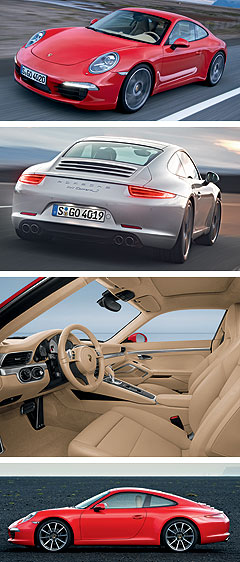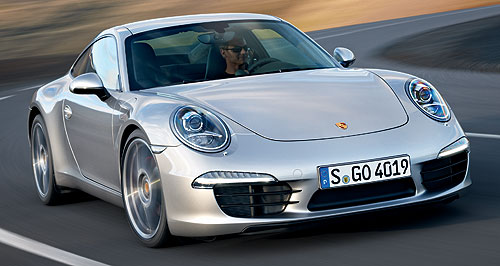Make / Model Search
New models - Porsche - 911 - Carerra SNew Porsche 911 Carerra S fast as racy GT3Nice number: A weight loss program, more stable body and fresh engines make the new Porsche 911 go even faster. All-new Porsche 911 lops 13 seconds off its Nurburgring best lap time16 Sep 2011 By JAMES STANFORD in FRANKFURT THE new Porsche 911 is 13 seconds faster around the famed Nurburgring than the current model, lapping the German circuit in 7 min. 40 sec. in testing. Porsche 911 vehicle line director August Achleitner said the new 911 Carrera S, armed with a 20mm lower sports suspension and regular tyres, was now as fast around the famed circuit as the previous generation’s race-ready 911 GT3. The new 911, which made its public debut at the Frankfurt motor show this week, is due in Australia in March. After a series of documented spats with Nissan over which car was faster at Nurburging, the 911 or the Nissan GT-R, with the Nissan now claiming a 7m 24 sec time, Porsche no longer seems worried about pressing for the fastest possible times. “It is not so important for us it is just for comparison (with the previous model),” Mr Achleitner told GoAuto. The new time was set with a PDK dual-clutch automatic transmission and the new active Porsche Dynamic Chassis Control hydraulically activated anti-roll bar system – a different system to that used on the Panamera and Cayenne. The Type 991 version of the 911 has a new 3.4-litre six-cylinder boxer engine generating 3kW more than the 3.6-litre unit it replaces, while the Carerra S version manages 294kW (up 11kW).  A central part of improving the 911’s pace was keeping the weight under control. A central part of improving the 911’s pace was keeping the weight under control.Mr Achleitner said the 911 took on around 80kg in parts, including heavier wheels, idle-stop components and additional structural parts to meet current and future crash regulations. Even so, the engineers reduced the weight of the larger new model by between 35kg to 45kg. Mr Achleitner said the team drew inspiration from the motorcycle world during the weight reduction drive. “We had several workshops and we laid out all the parts on the table and discussed them and compared with motorcycle parts and why are they so light and we are heavy and then change them again,” he said. The regular 911 does not have carbon-fibre, but Mr Achleitner left the door open to using it for some elements of the sportier 911s and race cars. “We have some opportunity to take carbon fibre parts for sport versions and so on, for example the roof system … the whole module can be replaced with carbon fibre,” he said. “But for series production car, it (carbon-fibre) does not make sense because it is still too expensive, and from the production point of view we would expect problems with the process, being able to get out enough parts.” Mr Achleitner said Porsche used a reasonable amount of aluminium in the new 911, but maintained a steel body. “It is not our target to replace all the steel with aluminium,” he said. “Our target is to use the right material at the right place. We could not replace steel with aluminum because we would require much more space from the frames and so on.” The new 911 has taken on some high tensile steel, which Achleitner says has helped create a stiffer body which he said should be the most noticeable on the cabriolet.  Read moreAll motor show Alfa Romeo Alfa Romeo Abarth Abarth Alpine Alpine Alpina Alpina Audi Audi Aston Martin Aston Martin BMW BMW Bentley Bentley Chery Chery Brabham Brabham Chrysler Chrysler Chevrolet Chevrolet Cupra Cupra Citroen Citroen DS DS Dodge Dodge Fiat Fiat Ferrari Ferrari Foton Foton Ford Ford Great Wall Great Wall FPV FPV Haval Haval GWM GWM Honda Honda Holden Holden Hummer Hummer HSV HSV Infiniti Infiniti Hyundai Hyundai Jaguar Jaguar Isuzu Isuzu Kia Kia Jeep Jeep Land Rover Land Rover Lamborghini Lamborghini Lexus Lexus LDV LDV Mahindra Mahindra Lotus Lotus Mazda Mazda Maserati Maserati Mercedes-AMG Mercedes-AMG McLaren McLaren MG MG Mercedes-Benz Mercedes-Benz Mitsubishi Mitsubishi Mini Mini Opel Opel Nissan Nissan Peugeot Peugeot Pagani Pagani Proton Proton Porsche Porsche Renault Renault Ram Ram Rover Rover Rolls-Royce Rolls-Royce Skoda Skoda Saab Saab SsangYong SsangYong Smart Smart Suzuki Suzuki Subaru Subaru Toyota Toyota Tesla Tesla Volvo VolvoMotor industry news |
Click to shareAll motor show Alfa Romeo Alfa Romeo Abarth Abarth Alpine Alpine Alpina Alpina Audi Audi Aston Martin Aston Martin BMW BMW Bentley Bentley Chery Chery Brabham Brabham Chrysler Chrysler Chevrolet Chevrolet Cupra Cupra Citroen Citroen DS DS Dodge Dodge Fiat Fiat Ferrari Ferrari Foton Foton Ford Ford Great Wall Great Wall FPV FPV Haval Haval GWM GWM Honda Honda Holden Holden Hummer Hummer HSV HSV Infiniti Infiniti Hyundai Hyundai Jaguar Jaguar Isuzu Isuzu Kia Kia Jeep Jeep Land Rover Land Rover Lamborghini Lamborghini Lexus Lexus LDV LDV Mahindra Mahindra Lotus Lotus Mazda Mazda Maserati Maserati Mercedes-AMG Mercedes-AMG McLaren McLaren MG MG Mercedes-Benz Mercedes-Benz Mitsubishi Mitsubishi Mini Mini Opel Opel Nissan Nissan Peugeot Peugeot Pagani Pagani Proton Proton Porsche Porsche Renault Renault Ram Ram Rover Rover Rolls-Royce Rolls-Royce Skoda Skoda Saab Saab SsangYong SsangYong Smart Smart Suzuki Suzuki Subaru Subaru Toyota Toyota Tesla Tesla Volvo VolvoMotor industry news |











Facebook Twitter Instagram